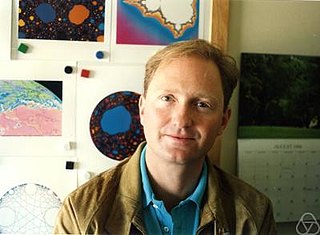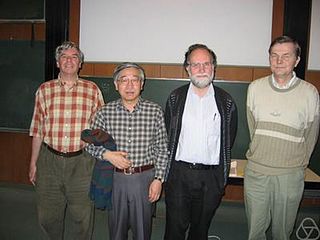Related Research Articles

Curtis Tracy McMullen is an American mathematician who is the Cabot Professor of Mathematics at Harvard University. He was awarded the Fields Medal in 1998 for his work in complex dynamics, hyperbolic geometry and Teichmüller theory.

Geometric group theory is an area in mathematics devoted to the study of finitely generated groups via exploring the connections between algebraic properties of such groups and topological and geometric properties of spaces on which these groups act.

In mathematics, a Kleinian group is a discrete subgroup of the group of orientation-preserving isometries of hyperbolic 3-space H3. The latter, identifiable with PSL(2, C), is the quotient group of the 2 by 2 complex matrices of determinant 1 by their center, which consists of the identity matrix and its product by −1. PSL(2, C) has a natural representation as orientation-preserving conformal transformations of the Riemann sphere, and as orientation-preserving conformal transformations of the open unit ball B3 in R3. The group of Möbius transformations is also related as the non-orientation-preserving isometry group of H3, PGL(2, C). So, a Kleinian group can be regarded as a discrete subgroup acting on one of these spaces.
In mathematics, the Teichmüller space of a (real) topological surface is a space that parametrizes complex structures on up to the action of homeomorphisms that are isotopic to the identity homeomorphism. Teichmüller spaces are named after Oswald Teichmüller.
In mathematics, Mostow's rigidity theorem, or strong rigidity theorem, or Mostow–Prasad rigidity theorem, essentially states that the geometry of a complete, finite-volume hyperbolic manifold of dimension greater than two is determined by the fundamental group and hence unique. The theorem was proven for closed manifolds by Mostow and extended to finite volume manifolds by Marden (1974) in 3 dimensions, and by Prasad in all dimensions at least 3. Gromov (1981) gave an alternate proof using the Gromov norm. Besson, Courtois & Gallot (1996) gave the simplest available proof.

Dennis Parnell Sullivan is an American mathematician known for his work in algebraic topology, geometric topology, and dynamical systems. He holds the Albert Einstein Chair at the City University of New York Graduate Center and is a distinguished professor at Stony Brook University.
Lipman Bers was a Latvian-American mathematician, born in Riga, who created the theory of pseudoanalytic functions and worked on Riemann surfaces and Kleinian groups. He was also known for his work in human rights activism.
Brian Hayward Bowditch is a British mathematician known for his contributions to geometry and topology, particularly in the areas of geometric group theory and low-dimensional topology. He is also known for solving the angel problem. Bowditch holds a chaired Professor appointment in Mathematics at the University of Warwick.

Zlil Sela is an Israeli mathematician working in the area of geometric group theory. He is a Professor of Mathematics at the Hebrew University of Jerusalem. Sela is known for the solution of the isomorphism problem for torsion-free word-hyperbolic groups and for the solution of the Tarski conjecture about equivalence of first-order theories of finitely generated non-abelian free groups.
James W. Cannon is an American mathematician working in the areas of low-dimensional topology and geometric group theory. He was an Orson Pratt Professor of Mathematics at Brigham Young University.
In the mathematical theory of Kleinian groups, the density conjecture of Lipman Bers, Dennis Sullivan, and William Thurston, later proved independently by Namazi & Souto (2012) and Ohshika (2011), states that every finitely generated Kleinian group is an algebraic limit of geometrically finite Kleinian groups.
In geometric group theory, the Rips machine is a method of studying the action of groups on R-trees. It was introduced in unpublished work of Eliyahu Rips in about 1991.
In mathematics, a quasicircle is a Jordan curve in the complex plane that is the image of a circle under a quasiconformal mapping of the plane onto itself. Originally introduced independently by Pfluger (1961) and Tienari (1962), in the older literature they were referred to as quasiconformal curves, a terminology which also applied to arcs. In complex analysis and geometric function theory, quasicircles play a fundamental role in the description of the universal Teichmüller space, through quasisymmetric homeomorphisms of the circle. Quasicircles also play an important role in complex dynamical systems.
In mathematics, the curve complex is a simplicial complex C(S) associated to a finite-type surface S, which encodes the combinatorics of simple closed curves on S. The curve complex turned out to be a fundamental tool in the study of the geometry of the Teichmüller space, of mapping class groups and of Kleinian groups. It was introduced by W.J.Harvey in 1978.
In mathematics, a convergence group or a discrete convergence group is a group acting by homeomorphisms on a compact metrizable space in a way that generalizes the properties of the action of Kleinian group by Möbius transformations on the ideal boundary of the hyperbolic 3-space . The notion of a convergence group was introduced by Gehring and Martin (1987) and has since found wide applications in geometric topology, quasiconformal analysis, and geometric group theory.

Jeffrey Farlowe Brock is an American mathematician, working in low-dimensional geometry and topology. He is known for his contributions to the understanding of hyperbolic 3-manifolds and the geometry of Teichmüller spaces.
Christopher Bishop is an American mathematician on the faculty at Stony Brook University. He received his bachelor's in mathematics from Michigan State University in 1982, going on from there to spend a year at Cambridge University, receiving at Cambridge a Certificate of Advanced Study in mathematics, before entering the University of Chicago in 1983 for his doctoral studies in mathematics. As a graduate student in Chicago, his advisor, Peter Jones, took a position at Yale University, causing Bishop to spend the years 1985–87 at Yale as a visiting graduate student and programmer. Nonetheless, he received his PhD from the University of Chicago in 1987.
Albert Marden is an American mathematician, specializing in complex analysis and hyperbolic geometry.
Godfrey Peter Scott, known as Peter Scott, was a British-American mathematician, known for the Scott core theorem.

Samuel James Patterson is a Northern Irish mathematician specializing in analytic number theory. He has been a professor at the University of Göttingen since 1981.
References
- ↑ Ellonen, Leena, ed. (2008). Suomen professorit 1640–2007 Finlands professorer (in Finnish and Swedish). Helsinki: Professoriliitto. p. 753. ISBN 978-952-99281-1-8.
- ↑ "Tukia, Pekka". University of Helsinki.
- ↑ Pekka Tukia at the Mathematics Genealogy Project
- ↑ Préaux, Jean-Philippe (2012). "A survey on Seifert fibre space conjecture". arXiv: 1202.4142 [math.AT].